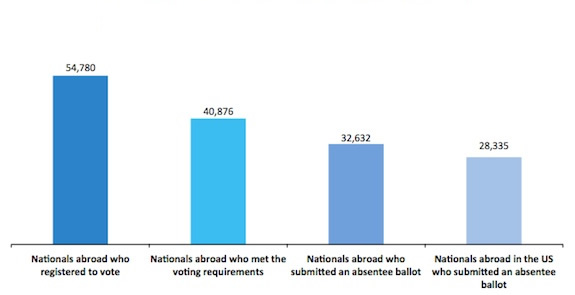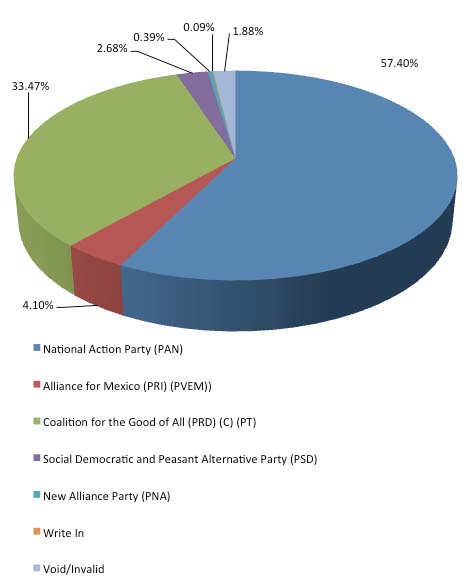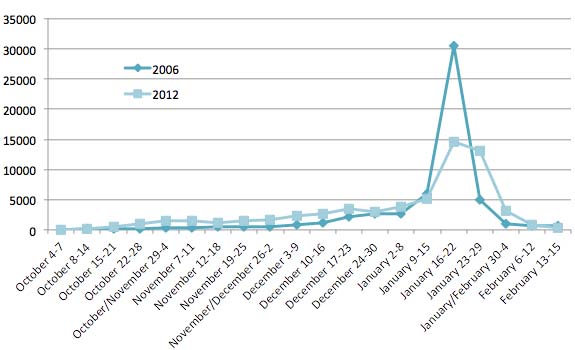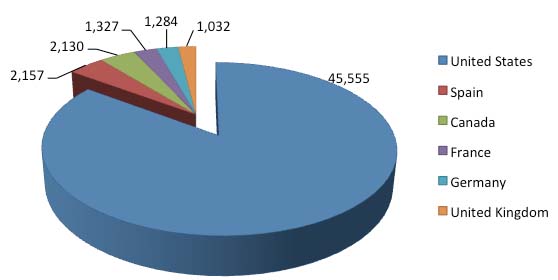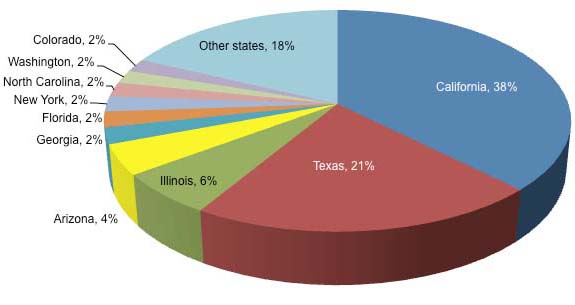The 2012 Mexican Presidential Election and Mexican Immigrants of Voting Age in the United States
An estimated 11.9 million Mexican citizens resided outside of Mexico in 2010, primarily in the United States, but also in Canada, Spain, Bolivia, Germany, Guatemala, and countries throughout the rest of the world. According to World Bank estimates, Mexican citizens sent home over US$257 billion in remittances between 1990 and 2010, contributing to the national economy and helping their families, friends, and other networks cope during times of economic hardship.
Given its large size and financial contribution to the country throughout the years, Mexico's diaspora began pressuring the Mexican government to allow them to participate in the country's political decision-making process in the 1990s. In 2005, Mexicans living abroad were granted voting privileges for presidential elections taking place in their country of origin, and they voted for the first time during the 2006 presidential election.
This summer, the Mexican diaspora will once again have the opportunity to vote for the Mexican president. In order to vote in the election, scheduled for July 1, 2012, a person must be a Mexican citizen (either by birth or naturalization), be at least 18 years of age, be registered on the Federal Electoral Institute's (IFE) Federal Registry of Voters, and have a valid voting ID card (credencial electoral).
This article discusses the history and process of external voting in Mexico, the participation of the Mexican diaspora in the 2006 Mexican presidential election, and the prospects for participation in the 2012 election. Utilizing the most recently available data from the U.S. Census Bureau, the article then goes on to explore the size, geographical distribution, and characteristics of voting-age members of the Mexican diaspora in the United States.
Click on the bullet points below for more information on each topic:
Background
- The External-Voting Process in Mexico
- The 2006 Mexican Presidential Election
- The 2012 Mexican Presidential Election
Data related to Mexican Immigrants of Voting Age in the United States
- In 2010, over 11.7 million Mexican immigrants (of all ages) resided in the United States.
- There were more than 10.6 million Mexican immigrants ages 18 and older in the United States.
- Nearly half of Mexican adults reside in two states: California and Texas.
- About three-quarters of Mexican adults residing in the United States were non-U.S. citizens in 2010.
- Nearly two-thirds of adult Mexican immigrants in the United States came after 1990.
- Six in ten Mexican immigrants in the United States did not have a high school diploma in 2010.
- In 2010, three out of four Mexican immigrant adults were limited English proficient.
- More than one-third of all employed Mexican-born men reported working in construction, extraction, and transportation in 2010.
- Over 62 percent of Mexican adults living in the United States were in low-income families in 2010.
In order to understand the eventual granting of voting privileges to Mexicans living abroad, it is important to first explore the political context in which the debate on the issue was carried out.
For over 70 years, Mexico's political system was dominated by the Institutional Revolutionary Party (PRI), which was originally founded in 1929 and won every presidential election in Mexico until the year 2000. The PRI consolidated power during the 1920s and 1930s, as Mexico was recovering from civil war and becoming able again to guarantee economic and political stability. During the economic crisis of the 1970s and 1980s, public debt led to high unemployment and, over time, popular disillusionment with the PRI. Electoral reforms in the early 1980s resulted in a slow move towards a multiparty political system in Mexico, ultimately culminating in the election of the first non-PRI governor in Baja California in 1989. Changes to the country's electoral system continued through the 1990s and resulted in the creation of the independent Federal Electoral Institute (IFE) in 1996. In 2000, Vicente Fox became the first non-PRI politician in over 70 years to win the Mexican presidency.
The growth of a multiparty system in Mexican politics coincided with increasing demands for external voting privileges by Mexico's large migrant community living abroad. With 4.3 million Mexicans living outside of Mexico during the 1990s, various migrant leaders and community organizations pressured policymakers in Mexico to consider granting expatriates the right to vote. This external pressure reinforced the calls for electoral reform occurring within Mexico.
In 1996, in accordance with the agreements established in Mexico's Political Reform of the State, the Mexican government modified the constitutional requirement requiring citizens to vote within their residential district — an amendment that paved the way for external voting legislation some nine years later. Between 1998 and 2004, 20 bills regarding external voting were presented to the Mexican Congress. Despite attempts to weaken or block such legislation on the part of some politicians, a law allowing the Mexican diaspora to vote in presidential elections was passed in 2005.
Over the past seven years, Mexico has made progress in improving its external-voting process, but there are still many obstacles that hinder full electoral participation by Mexicans living abroad.
|
External Voting Around the World
|
||
|
The External-Voting Process in Mexico
In order to vote in Mexico's presidential elections, Mexican nationals living abroad must meet all the standard voting requirements and register for IFE's Registry of Electoral Residents Abroad (Lista Nominal de Electores Residentes en el Extranjero, or LNERE). Voting is open to all Mexican citizens ages 18 and older who have a valid voting ID card. Mexican nationals can register for the LNERE by going to their local Mexican consulate or embassy to pick up the registration application, or by printing an application from the Internet. The registration application must then be mailed to IFE during the designated registration time. For the 2012 presidential election, the registration period ran from October 1, 2011 through January 15, 2012.
Once IFE has received the registration application and establishes that the applicant is eligible to vote, it will send the applicant a postal electoral packet (PEP). For the 2012 election, PEP's were scheduled to be mailed between April 16, 2012 and May 20, 2012. The electoral packet includes:
- Instructions for casting the absentee ballot.
- Information regarding the candidates and their platforms.
- A DVD containing the presidential candidates' messages.
- An absentee ballot.
- An absentee-ballot envelope (absentee ballot must be put into this envelope).
- A prepaid postal-return envelope.
For the 2012 presidential election, absentee ballots must be received by IFE before 8:00 am on June 30 in order to be counted. Any absentee ballots received after the deadline will not be counted and will be destroyed. The ballots that arrive on time will be counted on July 1, 2012 along with the rest of the votes cast in Mexico's 2012 presidential election.
The 2006 Mexican Presidential Election
Despite the large investment by the Mexican government to reach Mexico's estimated 4.2 million eligible Mexican voters abroad, only 54,780 Mexicans registered for the LNERE ahead of the 2006 presidential election. Of those, about 75 percent (40,876) met the registration requirements and were qualified to vote, and 59 percent (32,632) ultimately cast absentee ballots. Of the 32,632 ballots received, 87 percent (28,335) came from the United States.
|
(2006 Mexican Presidential Election) |
||
|
In 2006, Felipe Calderon of the conservative National Action Party (PAN) and Andres Manuel Lopez Obrador of the Party of the Democratic Revolution (PRD) were the primary beneficiaries of the absentee vote, together receiving 91 percent of the ballots cast from abroad in 2006. Fifty-eight percent (19,016) of the votes went to the PAN; 33 percent (11,088) went to the leftist Coalition for the Good of All, an alliance between the Party of the Democratic Revolution (PRD), Convergence, and the Labor Party; and 4 percent (1,360) went to the Alliance for Mexico, which consisted of the Ecologist Green Party of Mexico and the Institutional Revolutionary Party (PRI).
|
(2006 Mexican Presidential Election) |
||
|
Overall, the external voting-participation rate was significantly less than what the Mexican government had expected, and voter participation within Mexico was much higher. During the 2006 presidential election, 59 percent of eligible voters within Mexico (41.8 million Mexicans) exercised their right to vote, compared to close to 1 percent of eligible Mexican nationals abroad.
It is worth noting, however, that only 243,934 votes (less than 1 percent) separated the winning candidate, Calderon, from the second-place candidate, Lopez Obrador, in the 2006 election. In terms of votes cast in Mexico, Calderon and Lopez Obrador still received the majority of the votes with 71 percent combined, although the extent of support was substantially less than that received from abroad. Therefore, there is potential for Mexican absentee voters to influence Mexican election results, though it appears that Mexicans abroad were not as willing or able to vote in the 2006 election as the Mexican government had thought.
Among the reasons for the low external-voter turnout in the 2006 Mexican presidential election were:
- The lack of familiarity regarding the absentee-voting process.
- The inability/unwillingness to pay for the certified postage required to mail the absentee ballot back to Mexico.
- The unwillingness by many unauthorized Mexicans to return to Mexico to obtain the required voting ID (credencial electoral).
- The fear by unauthorized Mexican nationals that U.S. authorities would intercept the mailed ballots and use the information to track them down.
Funding for external voting in the 2006 Mexican presidential election was administered by the IFE, which invested USD$27.7 million (305 million pesos) to organize and implement the external-voting process. The IFE spent USD$10.8 million (119.3 million pesos) on preliminary arrangements in 2005 and USD$16.9 million (186 million pesos) during the implementation phase in 2006.
The 2012 Mexican Presidential Election
Mexicans living abroad have already begun to plan their participation in Mexico's presidential election taking place this summer. By February 15, 2012, IFE had received more requests for absentee ballots for the 2012 election than it did in 2006, with around 61,687 absentee ballots requested from over 100 countries (compared to 56,749 in 2006). However, the increase of 4,938 absentee-ballot requests was not a significant improvement given the changes implemented by IFE to facilitate the registration process and increase participation.
Figure 3 (below) indicates the number of absentee-ballot requests received throughout the registration time period.
|
|
||
|
As was the case in 2006, most absentee-ballot requests have come from the United States, with the second-largest number of requests coming from Spain. Absentee-ballot requests were also received from Mexicans living in Canada, France, Germany, and the United Kingdom.
|
|
||
|
Within the United States, the largest number of absentee-ballot requests — 12,908 or 28 percent of all U.S. requests — came from California, the state with the largest Mexican-immigrant population. The next two states with the most numerous absentee-ballot requests were Texas (16 percent) and Illinois (11 percent), home to the second- and third-largest number of Mexican immigrants in the United States, respectively. Other states with large numbers of absentee-ballot requests included Florida (7 percent), New York (6 percent), and Arizona (5 percent).
|
|
||||||||||||||||||||||||||||||||||||||||||||||||||||||||||||||
|
Data Related to Mexican Immigrants of Voting Age in the United States
The remainder of this Spotlight focuses on Mexican-born immigrants ages 18 and older residing in the United States, and draws on the U.S. Census Bureau's 2010 American Community Survey (ACS) to examine the population's size, geographic distribution, and a number of demographic and socioeconomic characteristics.
Not all of the 10.6 million Mexicans described below are currently eligible to vote in the elections in Mexico because they might not be registered with IFE, might not have a valid voting ID card, and/or might not meet other eligibility requirements. For instance, of all Mexican nationals living abroad, only 4.2 million were estimated to be eligible to vote in Mexico's 2006 presidential election. However, only 32,632 Mexican nationals living abroad submitted an absentee ballot.
In 2010, over 11.7 million Mexican immigrants (of all ages) resided in the United States.
Mexican immigrants became the largest immigrant group in the United States in the 1980s, constituting 16 percent of the total 14.1 million foreign born that year. By 2010, the share of Mexican immigrants among all immigrants grew to 29 percent of the total 40 million immigrants at that time. (See figures showing the top ten countries of birth of immigrants residing in the United States over time here.)
There were more than 10.6 million Mexican immigrants ages 18 and older in the United States in 2010.
According to the 2010 ACS, more than 10.6 million immigrants were born in Mexico and were at least 18 years of age, which potentially makes them eligible to vote in Mexico's general presidential election. This number does not include those who were born outside of Mexico, became naturalized Mexican citizens, and now reside in the United States. The ACS data do not provide information about respondents' foreign citizenship.
Nearly half of Mexican adults reside in two states: California and Texas.
Although most Mexican immigrants are concentrated in the West and Southwest — with California and Texas home to 59 percent — increasing numbers have begun moving to less traditional immigrant destinations such as Georgia and North Carolina over the years. In 2010, the five states with the largest percentage of foreign-born Mexicans were California (38 percent), Texas (21 percent), Illinois (6 percent), Arizona (4 percent), and Georgia (2 percent). Together, these five states were home to 72 percent of the 10.6 million Mexican-immigrant adults living in the United States. Another 12 percent resided in Florida, New York, North Carolina, Washington, Colorado, and Nevada (about 2 percent each).
|
|
||
|
About three-quarters of Mexican adults residing in the United States were non-U.S. citizens in 2010.
Roughly 75 percent of Mexican adults ages 18 and older residing in the United States indicated that they were not U.S. citizens in 2010. One-quarter of Mexican immigrants indicated that they became U.S. citizens through naturalization.
Nearly two-thirds of adult Mexican immigrants in the United States came after 1990.
As of 2010, 30 percent of the 10.6 million Mexican-born adults living in the United States had entered the country after 2000. Another 32 percent reported migrating to the United States between 1990 and 1999, while 38 percent entered the country before 1990.
Six in ten Mexican immigrants in the United States in 2010 did not have a high school diploma in 2010.
Of the 9.4 million Mexican immigrants ages 25 and older living in the United States in 2010, 60 percent had no high school diploma — nearly twice as many as among the overall foreign-born adult population (32 percent). About 35 percent of Mexican immigrants had either a high school degree/GED or some uncompleted college education. Among those with higher levels of education, only 5 percent of Mexican immigrants had at least a bachelor's degree, compared to 27 percent of foreign-born adults overall.
In 2010, three out of four Mexican-immigrant adults were limited English proficient.
Three-quarters of the 10.6 million Mexican adults residing in the United States reported having limited English proficiency in 2010.
Note: The term "Limited English Proficient" refers to any person who reported speaking English "not at all," "not well," or "well" on their survey questionnaire. Individuals who reported speaking only English or speaking English "very well" are considered proficient in English.
More than one-third of all employed Mexican-born men reported working in construction, extraction, and transportation in 2010.
Among the roughly 4.5 million Mexican-born male workers ages 18 and older in the civilian labor force in 2010, 34 percent reported working in construction, extraction, and transportation occupations; 25 percent reported employment in services and personal care occupations; and 18 percent reported employment in manufacturing, installation, and repair (see Table 2).
|
|
|||||||||||||||||||||||||||||||||||||||||||||||||||||
|
With an 88-percent participation rate, Mexican-born men were substantially more likely to be in the civilian labor force in 2010 than were Mexican-born women (54 percent). Among the approximately 2.3 million Mexican-born female workers ages 18 and older, nearly 40 percent reported working in services and personal care occupations; 13 percent were employed in manufacturing, installation, and repair occupations; and about 11 percent each in sales and administrative support.
Over 62 percent of Mexican adults living in the United States were in low-income families in 2010.
According to the 2010 ACS, over one-quarter (26 percent) of Mexican adults lived below the poverty line, while another 36 percent were in families with annual incomes between 100 and 199 percent below the official poverty level. This means that about 62 percent of Mexican adults living in the United States are in low-income families. The remaining 38 percent of Mexican adults were above 200 percent of the poverty line.
Note: Poverty is defined as individuals residing in families with a total annual income below the federal poverty line. Families with annual incomes below 200 percent of the poverty line are considered "low income." Whether an individual falls below the official poverty line depends not only on total family income, but also on the size of the family, the number of children, and the age of the householder. ACS reports total income over the 12 months preceding the interview date.
Sources
Hernández Pérez, Víctor and Gustavo Meixueiro Nájera. Debate en México sobre el voto en el extranjero. Mexico, DF: Centro de Estudios Sociales y de Opinión Publica. Available Online.
Instituto Federal Electoral. Elección de Presidente de los EUM. Available Online.
Instituto Federal Electoral. 2006. Instrumentación y resultados del voto de los mexicanos residentes en el extranjero. México, DF: Instituto Federal Electoral. Available Online.
Instituto Federal Electoral. Recepción y procesamiento de Solicitudes de Inscripción a la Lista Nominal de Electores Residentes en el Extranjero. Available Online.
International Institute for Democracy and Electoral Assistance (IDEA). 2007. Voting from Abroad. Stockholm: International Institute for Democracy and Electoral Assistance (IDEA). Available Online.
Ruiz, Jose Luis. 2005. Se firma decreto para el voto de mexicanos en el extranjero. El Universal, July 1, 2005. Available Online.
Suro, Roberto and Gabriel Escobar. 2006. Survey of Mexicans Living in the U.S. on Absentee Voting in Mexican Elections. Washington, DC: Pew Hispanic Center. Available Online.
Voto de los Mexicanos Residentes en el Extranjero. Piezas postales recibidas. Available Online.
Voto de los Mexicanos Residentes en el Extranjero. Preguntas frecuentes. Available Online.
Washington Post. Mexico Votes 2006. Available Online.



